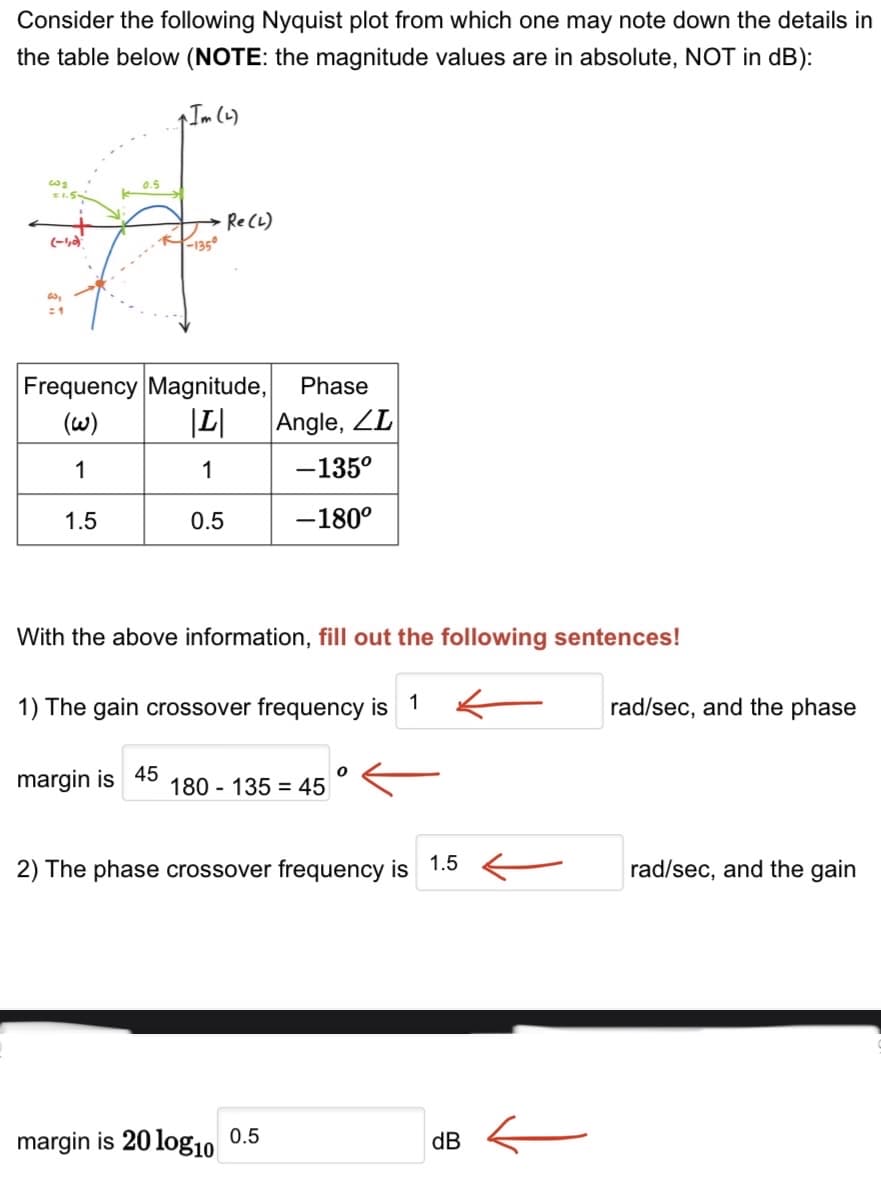Consider the following Nyquist plot from which one may note down the details in the table below (NOTE: the magnitude values are in absolute, NOT in dB): ↑ Im (4) 0.5 # -135⁰ ون =1 Frequency Magnitude, Phase |L| Angle, ZL (w) 1 1 -135° -180° 1.5 Re (L) 0.5 With the above information, fill out the following sentences! 1) The gain crossover frequency is 1 ← 45 0 margin is 180-135 = 45 2) The phase crossover frequency 1.5 is ← margin is 20 log10 0.5 dB rad/sec, and the phase rad/sec, and the gain
Consider the following Nyquist plot from which one may note down the details in the table below (NOTE: the magnitude values are in absolute, NOT in dB): ↑ Im (4) 0.5 # -135⁰ ون =1 Frequency Magnitude, Phase |L| Angle, ZL (w) 1 1 -135° -180° 1.5 Re (L) 0.5 With the above information, fill out the following sentences! 1) The gain crossover frequency is 1 ← 45 0 margin is 180-135 = 45 2) The phase crossover frequency 1.5 is ← margin is 20 log10 0.5 dB rad/sec, and the phase rad/sec, and the gain
Introductory Circuit Analysis (13th Edition)
13th Edition
ISBN:9780133923605
Author:Robert L. Boylestad
Publisher:Robert L. Boylestad
Chapter1: Introduction
Section: Chapter Questions
Problem 1P: Visit your local library (at school or home) and describe the extent to which it provides literature...
Related questions
Question
100%
Please solve as some answers may be wrong

Transcribed Image Text:Consider the following Nyquist plot from which one may note down the details in
the table below (NOTE: the magnitude values are in absolute, NOT in dB):
↑ Im (4)
C₂
0.5
#
(-1,0)
-135⁰
=1
Frequency Magnitude, Phase
|L| Angle, LL
(w)
1
1
-135°
-180°
1.5
Re (L)
0.5
With the above information, fill out the following sentences!
1) The gain crossover frequency is 1 ←
45
0
margin is 180-135 = 45
2) The phase crossover frequency 1.5
is ←
margin is 20 log10 0.5
dB
rad/sec, and the phase
rad/sec, and the gain
Expert Solution
This question has been solved!
Explore an expertly crafted, step-by-step solution for a thorough understanding of key concepts.
Step by step
Solved in 4 steps with 1 images

Knowledge Booster
Learn more about
Need a deep-dive on the concept behind this application? Look no further. Learn more about this topic, electrical-engineering and related others by exploring similar questions and additional content below.Recommended textbooks for you

Introductory Circuit Analysis (13th Edition)
Electrical Engineering
ISBN:
9780133923605
Author:
Robert L. Boylestad
Publisher:
PEARSON

Delmar's Standard Textbook Of Electricity
Electrical Engineering
ISBN:
9781337900348
Author:
Stephen L. Herman
Publisher:
Cengage Learning

Programmable Logic Controllers
Electrical Engineering
ISBN:
9780073373843
Author:
Frank D. Petruzella
Publisher:
McGraw-Hill Education

Introductory Circuit Analysis (13th Edition)
Electrical Engineering
ISBN:
9780133923605
Author:
Robert L. Boylestad
Publisher:
PEARSON

Delmar's Standard Textbook Of Electricity
Electrical Engineering
ISBN:
9781337900348
Author:
Stephen L. Herman
Publisher:
Cengage Learning

Programmable Logic Controllers
Electrical Engineering
ISBN:
9780073373843
Author:
Frank D. Petruzella
Publisher:
McGraw-Hill Education

Fundamentals of Electric Circuits
Electrical Engineering
ISBN:
9780078028229
Author:
Charles K Alexander, Matthew Sadiku
Publisher:
McGraw-Hill Education

Electric Circuits. (11th Edition)
Electrical Engineering
ISBN:
9780134746968
Author:
James W. Nilsson, Susan Riedel
Publisher:
PEARSON

Engineering Electromagnetics
Electrical Engineering
ISBN:
9780078028151
Author:
Hayt, William H. (william Hart), Jr, BUCK, John A.
Publisher:
Mcgraw-hill Education,